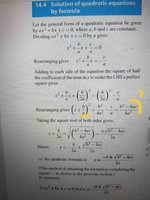Yuseph
Junior Member
- Joined
- Aug 5, 2020
- Messages
- 68
Yo guys,
Im finished with the quadratic equations. But i have a couple of questions.
- i suppose you guys dont use the factorization method. it looks like its meant for total beginners. So what dyou do instead. Completing the square or the quadratic formula or graphs ?
- there re different levels of equations. And correct me if im wrong. Heres what i understood so far. Simple equation is when you have one unknown and this unknow can take only one value. You only need one equation to solve it. The only skill required is knowing cross multiplication. Simultaneous equation is when you have 2 unknown. You need two proportionnal equations to solve it otherwise its not valid. Both unknow can only take one value each. Then you have quadratic equation. Whenever you see a squared unknown thats the method you should apply. And the power raised can only be power 2 no more. Now im too much of a beginner to figure out why when theres no y involved x can takes two values. Its just too new for me to be able to explain it to myself.
- looking at the picture can you tell me why the denominator is a instead of 2a, is it a typo ? Because if thats true im totally lost. Also looking at the right hand side can you tell me how the author got to b^2 - 4ac divided by 4a^2. Ive never seen something like that since i started. How can you just move c/a like that and put it on top ?
Thanks. after that ill be working on logarithm i think this is the chapter where i can start fooling people and make them believe im smarter than they imagined even if nothing changed hehe
Im finished with the quadratic equations. But i have a couple of questions.
- i suppose you guys dont use the factorization method. it looks like its meant for total beginners. So what dyou do instead. Completing the square or the quadratic formula or graphs ?
- there re different levels of equations. And correct me if im wrong. Heres what i understood so far. Simple equation is when you have one unknown and this unknow can take only one value. You only need one equation to solve it. The only skill required is knowing cross multiplication. Simultaneous equation is when you have 2 unknown. You need two proportionnal equations to solve it otherwise its not valid. Both unknow can only take one value each. Then you have quadratic equation. Whenever you see a squared unknown thats the method you should apply. And the power raised can only be power 2 no more. Now im too much of a beginner to figure out why when theres no y involved x can takes two values. Its just too new for me to be able to explain it to myself.
- looking at the picture can you tell me why the denominator is a instead of 2a, is it a typo ? Because if thats true im totally lost. Also looking at the right hand side can you tell me how the author got to b^2 - 4ac divided by 4a^2. Ive never seen something like that since i started. How can you just move c/a like that and put it on top ?
Thanks. after that ill be working on logarithm i think this is the chapter where i can start fooling people and make them believe im smarter than they imagined even if nothing changed hehe

